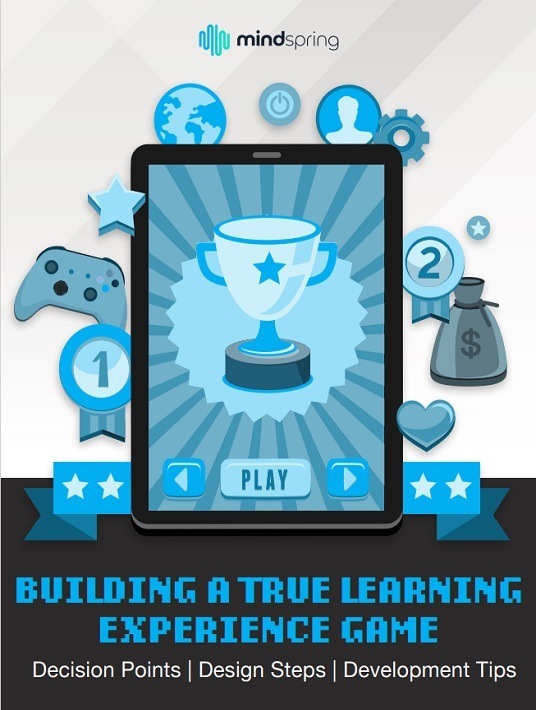How To Choose The Best Game Development Outsourcing Partner
This article is part of a series on building a true training game to increase managers’ understanding of corporate finance. What you are about to read is a fable. The company, AshCom, is fictional, but the learning challenges faced by Kathryn, AshCom’s CLO, and her team are real and commonly shared by learning teams in large organizations. It is our hope that you will be able to connect with the characters, their challenges, and the solutions they discover. We also invite you to read the first eBook in the series.

Shifting Roles
In her previous job at Globex Manufacturing, Adeena was known as an instructional designer with strong project management skills. Her colleagues, Darryl and Martina, were also skilled in instructional design, but they were more known for their creativity and artistry.
When AshCom Manufacturing acquired Globex, Adeena, Darryl, and Martina were offered positions on AshCom’s learning team led by Kathryn, the Chief Learning Officer. All three accepted, and all three continued in roles similar to what they had at Globex.
Adeena’s role shifted unexpectedly and suddenly when Kathryn asked to meet with her on a Monday morning to discuss games. She wasn’t sure what to make of the request, but she showed up at Kathryn’s office on time and eager to learn more.
Kathryn explained that she had been approached by Kurtis, the Chief Financial Officer at AshCom. Kurtis had two concerns about the financial literacy of managers. The first was that there were hundreds of people in management positions at AshCom who made thousands of decisions every week that affected the company’s financial performance.
The second was a concern that, despite some attempts to deepen their understanding of corporate finances, most managers at AshCom had little grasp of how they worked or how to read a financial statement to understand the overall health of the company. They could certainly understand a budget, specifically their part of it, but they had little comprehension of how it all fit together.
Kurtis suspected the best people to address this were most likely on Kathryn’s learning team. They had impressed him with what they created for the sales team. The return on investment was clear and impressive. He also believed that the managers might respond well to some kind of competition.
Possible Solutions
Typical to her approach to significant challenges, Kathryn spent some time thinking about possible solutions to Kurtis’ problem. The word “competition” stuck with her, which led her to think about games. Could that be part of the solution? Her team had added game elements to more traditional eLearning modules, things like scoreboards and feedback.
But she was convinced that these modifications would not create the kind of enthusiasm for corporate finance that Kurtis was hoping for. She also knew that her team did not have deep experience in game theory and practice.
Adeena was the exception. Kathryn recalled that Adeena’s resume contained something about game design courses that were part of her education. After digging up her resume to confirm, Kathryn set a meeting on a Monday morning.
Adeena was surprised that Kathryn remembered that small detail and was thrilled when Kathryn asked her to make a presentation on games and game theory. What Kathryn did not know is that Adeena’s interest in gaming went far beyond a few courses in college and a general interest. Adeena had a deep appreciation for not only playing various games but also for the theory and mechanics built into them.
The learning team had already met twice to discuss game theory and Kurtis’ request for a financial literacy learning experience. At the end of the second meeting, Kathryn gave a summary sentence which framed what they decided to do: “So we are going to build a true game for hundreds of managers at AshCom with the goal of teaching them how corporate finance works. The game will combine strategy and role-playing using the key motivators of ownership, accomplishment, and social influence.”
After the second team meeting, Kathryn and Adeena met separately. Both shared the same concerns. While the big picture would provide a great deal of guidance, there were many unanswered questions.
Both also knew that their learning team did not have the experience, skills, or technical knowledge to actually build a true game. They would need to hire a partner to help them. The culture of AshCom was to avoid the term “vendor” when talking about hiring external firms. They preferred stronger relationships and so referred to them as “partners.”
Where To Find The Perfect Outsourcing Partner?
But where to find the right partner? Kathryn tasked Adeena with doing some research and coming back to her with three or four good options. To provide some guidance, Kathryn gave Adeena some parameters:
-Game building experience showing technical innovation
-Solid understanding of learning science
-Exceptionally creative
Adeena found the parameters to be helpful. She could use them to evaluate potential game building partners. It also occurred to her that finding the right partner might not be so easily done.
Her initial research confirmed her suspicion. There were many companies that had deep game-building experience. Some were small shops of only a few people. Some that were fairly large companies with more sophistication. She certainly found the experience in gaming. From the sample she received, there were varying degrees of creativity.
The big miss was a lack of understanding of or experience in learning science among the game companies. AshCom’s goal was not to merely entertain. What CFO Kurtis requested was a learning experience that would have tangible results. Playing a great game that didn’t move the needle on financial literacy would be a failure.
Adeena decided to shift the focus of her search. Instead of looking at game design companies, she wondered if she might find a better fit among companies that built custom learning experiences. They would almost certainly have a stronger understanding of learning science. But would any have the software skills and technical capabilities to build a game?
Weighing The Options
Adeena requested information from fifteen companies including some straight up game design companies and some more tuned to custom learning creation. She selected eight of these to interview hoping that, in the end, she would have a good list of three to bring to Kathryn’s attention.
Having never done something like this, it took Adeena longer than she anticipated. It was also more difficult than she imagined it would be. But as she dug in, the fog began to lift, and the three top contenders emerged.
Adeena set a meeting with Kathryn in the conference room to ensure that she would have ample whiteboard space.
“I’m really excited about this conversation,” said Kathryn at the start of their time together. “The choice of partner will be the key to the success of this program. So, what did you learn?”
“It was more challenging than I thought, so thanks for giving me time to sort this out,” said Adeena. “I’ve got the three possibilities. If you don’t mind, I’d like to keep their names secret until the ‘big reveal’ at the end. I want to focus on the data and put it up on the whiteboard.”
“Fine with me,” said Kathryn, appreciative of Adeena’s focus on information.
“First, let me talk a moment about my process. I looked at the websites of dozens of possible partners. I narrowed that to eight and dove deep into them. I looked at their samples and had multiple phone conversations. I took notes on each and then had follow-up calls with what I think are the top three contenders. I also scored them.”
Laughing, Kathryn said, “Exactly the approach I expected. I really appreciate the way you think in systems.”
Game Development Outsourcing: Charting It Out
“Actually, I made a grid,” said Adeena, which caused Kathryn to laugh harder.
Going to the whiteboard, Adeena drew a simple grid.
| Partner #1 | Partner #2 | Partner #3 | |
| Experience/Tech Innovation | |||
| Creativity | |||
| Learning Science | |||
| TOTAL |
“I like this,” said Kathryn.
“Let me put in the scores I came up with and then we can talk about why I scored them the way I did."
| Partner #1 | Partner #2 | Partner #3 | |
| Experience/Tech Innovation | 9 | 2 | 8 |
| Creativity | 7 | 7 | 7 |
| Learning Science | 2 | 8 | 10 |
| TOTAL | 19 | 17 | 25 |
“So, there is a clear winner?” asked Kathryn.
“I think there is. Possible Partner #1 is a well-known game design studio. They are 13 years old and have built some impressive games for sizable companies.”
“So, there is a clear winner?” asked Kathryn.
“I think there is. Possible Partner #1 is a well-known game design studio. They are 13 years old and have built some impressive games for sizable companies.”
“Which is why they scored a nine on experience,” said Kathryn.
“Exactly. They have the deep game design and build experience.”
“Creativity is a seven. Why is that? Actually, you rated all three about the same,” said Kathryn.
“I saw good creativity in each of them,” responded Adeena. “All of them are solid.”
“OK,” said Kathryn. “So why a score of two in Learning Science for Partner #1?
Adeena responded, “Little on their website told me they understood learning objectives or science. In my calls with them, all they wanted to talk about was game features. They were more than willing to show me cool examples, but they had no experience or, actually, any grasp of a learning experience. I’m afraid they would have to learn learning, so to speak, and I don’t think they are our best choice,” said Adeena.
“That’s a key. Let’s move on to potential partner #2. Tell me about them,” said Kathryn.
“They are almost the exact opposite as you can see from the scores,” said Adeena. “I thought I would explore custom content developers. As I suspected, they understood the learning science. They knew immediately what I meant by ‘learning experience.’”
“Let me guess,” said Kathryn. “They had never built a true game before.”
“You hit the nail on the head,” said Adeena. “They had experience in gamifying more traditional eLearning modules. Mostly similar to what we’ve done. They talked about finding a subcontractor who could possibly build a game for them and us. I gave them a score of two in game experience, but that was probably too gracious.”
“And that brings us to option #3. Tell me about them,” said Kathryn.
Building A Learning Experience
“They started as a custom content eLearning company more than a decade ago and have worked with some very large and well-known companies,” said Adeena. “They certainly understand the learning science. I gave them a 10 on Learning Science because they immediately talked about building a learning experience. I told them the general parameters of what we had, and they pushed me on doing a Needs Analysis and getting our learning objectives. As a matter of fact, they said we need to get these clear before we start talking about coding or games structures.”
“That’s reassuring,” said Kathryn. “But you also gave them an eight for Game Experience. Give me the justification for that.”
Adeena replied, “They’ve built some impressive games. There was a lot of creativity. I got to play a few of them. They have the IT skills to match the game design companies that have no learning science experience. I gave them a nine because not only have they built impressive games, but they also actually built a financial literacy game. It was for a large company in the European Union. There are some slight differences with what we have in mind, but they have a head start on everyone else. They could be up to speed very quickly.”
“We have winner!” shouted Kathryn. “Is now the time you tell me their name? I’ve been waiting for the big reveal.”
Adeena walked to the whiteboard and wrote ‘Inno-Versity!’
“Adeena,” said Kathryn in a more serious tone, “I’m impressed with what you’ve done here. Logical. Clear. Concise. Let’s set up a video call with them, introduce them to the team, and get a conversation going about pricing, timeline, and first steps.”
“Just what I was hoping to hear,” said Adeena. “I remain grateful for the confidence you have in me giving me this opportunity. I sure hope I can continue to be involved in this project.”
“You are running point here,” said Kathryn. “I and others will be there to support you as much as you need, but this is your project. You own it.”
With that, their meeting came to a close, both confident they had found a great partner option for building AshCom’s first true game.
Conclusion
To read the rest of the chapters in this series on building a true game to teach financial literacy and to see Kathryn and her team solve their challenges, please download the eBook Building A True Learning Experience Game: Decision Points, Design Steps, And Development Tips. Also, join the webinar for more insights to build a true game that wows your online learners.










